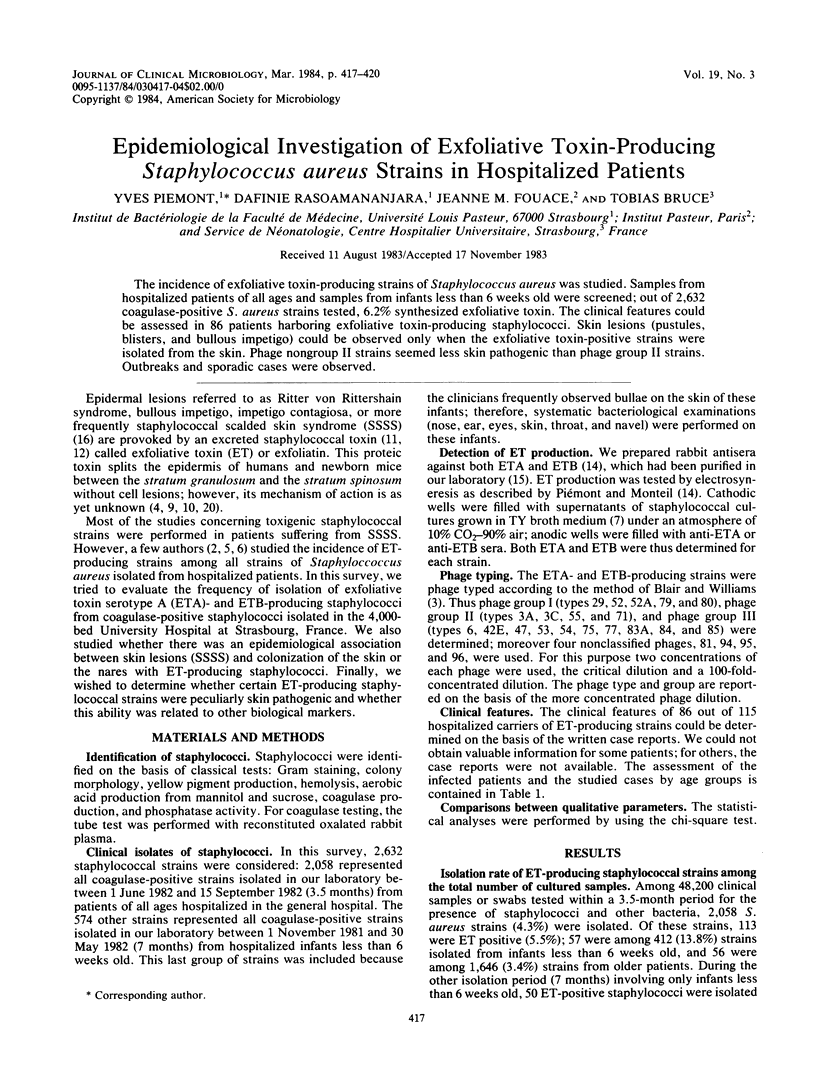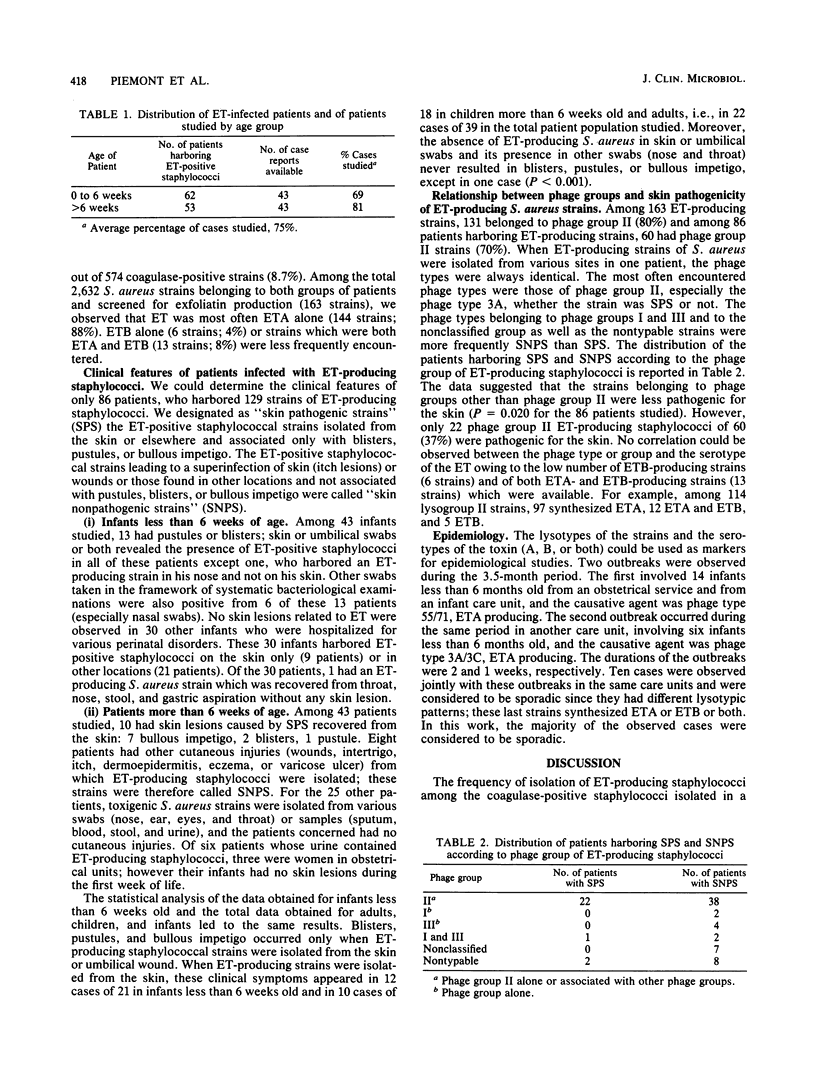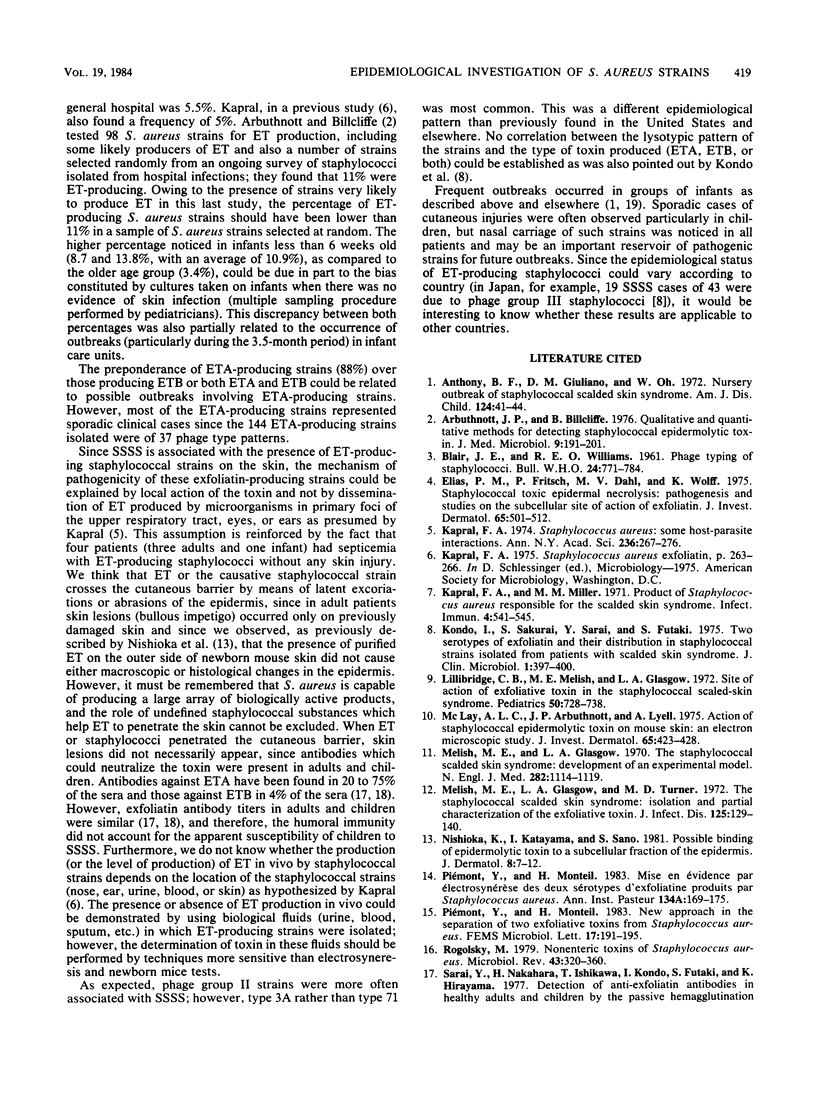Abstract
The incidence of exfoliative toxin-producing strains of Staphylococcus aureus was studied. Samples from hospitalized patients of all ages and samples from infants less than 6 weeks old were screened; out of 2,632 coagulase-positive S. aureus strains tested, 6.2% synthesized exfoliative toxin. The clinical features could be assessed in 86 patients harboring exfoliative toxin-producing staphylococci. Skin lesions (pustules, blisters, and bullous impetigo) could be observed only when the exfoliative toxin-positive strains were isolated from the skin. Phage nongroup II strains seemed less skin pathogenic than phage group II strains. Outbreaks and sporadic cases were observed.
Full text
PDF



Selected References
These references are in PubMed. This may not be the complete list of references from this article.
- Anthony B. F., Giuliano D. M., Oh W. Nursery outbreak of staphylococcal scalded skin syndrome. Rapid identification of the epidemic bacterial strain. Am J Dis Child. 1972 Jul;124(1):41–44. doi: 10.1001/archpedi.1972.02110130043006. [DOI] [PubMed] [Google Scholar]
- Arbuthnott J. P., Billcliffe B. Qualitative and quantitative methods for detecting staphylococcal epidermolytic toxin. J Med Microbiol. 1976 May;9(2):191–201. doi: 10.1099/00222615-9-2-191. [DOI] [PubMed] [Google Scholar]
- Elias P. M., Fritsch P., Dahl M. V., Wolff K. Staphylococcal toxic epidermal necrolysis: pathogenesis and studies on the subcellular site of action of exfoliatin. J Invest Dermatol. 1975 Dec;65(6):501–512. doi: 10.1111/1523-1747.ep12610196. [DOI] [PubMed] [Google Scholar]
- Kapral F. A., Miller M. M. Product of Staphylococcus aureus responsible for the scalded-skin syndrome. Infect Immun. 1971 Nov;4(5):541–545. doi: 10.1128/iai.4.5.541-545.1971. [DOI] [PMC free article] [PubMed] [Google Scholar]
- Kapral F. A. Staphylococcus aureus: some host-parasite interactions. Ann N Y Acad Sci. 1974 Jul 31;236(0):267–276. doi: 10.1111/j.1749-6632.1974.tb41497.x. [DOI] [PubMed] [Google Scholar]
- Kondo I., Sakurai S., Sarai Y., Futaki S. Two serotypes of exfoliatin and their distribution in staphylococcal strains isolated from patients with scalded skin syndrome. J Clin Microbiol. 1975 May;1(5):397–400. doi: 10.1128/jcm.1.5.397-400.1975. [DOI] [PMC free article] [PubMed] [Google Scholar]
- Lillibridge C. B., Melish M. E., Glasgow L. A. Site of action of exfoliative toxin in the staphylococcal scaled-skin syndrome. Pediatrics. 1972 Nov;50(5):728–738. [PubMed] [Google Scholar]
- McLay A. L., Arbuthnott J. P., Lyell A. Action of staphylococcal epidermolytic toxin on mouse skin: an electron microscopic study. J Invest Dermatol. 1975 Nov;65(5):423–428. doi: 10.1111/1523-1747.ep12608171. [DOI] [PubMed] [Google Scholar]
- Melish M. E., Glasgow L. A. The staphylococcal scalded-skin syndrome. N Engl J Med. 1970 May 14;282(20):1114–1119. doi: 10.1056/NEJM197005142822002. [DOI] [PubMed] [Google Scholar]
- Melish M. E., Glasgow L. A., Turner M. D. The staphylococcal scalded-skin syndrome: isolation and partial characterization of the exfoliative toxin. J Infect Dis. 1972 Feb;125(2):129–140. doi: 10.1093/infdis/125.2.129. [DOI] [PubMed] [Google Scholar]
- Nishioka K., Katayama I., Sano S. Possible binding of epidermolytic toxin to a subcellular fraction of the epidermis. J Dermatol. 1981 Feb;8(1):7–12. doi: 10.1111/j.1346-8138.1981.tb02005.x. [DOI] [PubMed] [Google Scholar]
- Piémont Y., Monteil H. Mise en évidence par électrosynérèse des deux sérotypes d'exfoliatine produits par Staphylococcus aureus. Ann Microbiol (Paris) 1983 Mar-Apr;134A(2):169–175. [PubMed] [Google Scholar]
- Rogolsky M. Nonenteric toxins of Staphylococcus aureus. Microbiol Rev. 1979 Sep;43(3):320–360. doi: 10.1128/mr.43.3.320-360.1979. [DOI] [PMC free article] [PubMed] [Google Scholar]
- Wiley B. B., Glasgow L. A., Rogolsky M. Staphylococcal scalded-skin syndrome: development of a primary binding assay for human antibody to the exfoliative toxin. Infect Immun. 1976 Feb;13(2):513–520. doi: 10.1128/iai.13.2.513-520.1976. [DOI] [PMC free article] [PubMed] [Google Scholar]
- Willard D., Monteil H., Piemont Y., Assi R., Messer J., Lavillaureix J., Minck R., Gandar R. L'exfoliatine dans les staphylococcies néonatales. Nouv Presse Med. 1982 Dec 18;11(51):3769–3771. [PubMed] [Google Scholar]
- Wuepper K. D., Dimond R. L., Knutson D. D. Studies of the mechanism of epidermal injury by a Staphylococcal epidermolytic toxin. J Invest Dermatol. 1975 Jul;65(1):191–200. doi: 10.1111/1523-1747.ep12598130. [DOI] [PubMed] [Google Scholar]


